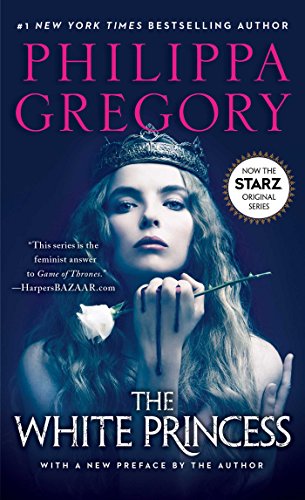The White Princess (MTI) (The Plantagenet and Tudor Novels)
Adapted for the STARZ original series, The White Princess.
Love to the Death.
When Henry Tudor picks up the crown of England from the mud of Bosworth field, he knows he must marry the princess of the enemy house—Elizabeth of York—to unify a country divided by war for more than three decades. But his bride is still in love with his dead enemy, and her mother and half of England remain loyal to her brother, the missing York heir.
Henry’s greatest fear is that somewhere a prince is waiting to reclaim the throne. When a young man who would be king invades England, Elizabeth has to choose between the new husband she is coming to love and the boy who claims to be her lost brother: the rose of York come home at last.
“A bloody irresistible read.” —People
“Bring on the blood, sex, and tears!…You name it, it’s all here.” —USA TODAY
Guest Review of The White Princess
By Tracy Chevalier

Tracy Chevalier is the New York Times best-selling author of Girl with a Pearl Earring. She was born in Washington, DC but has lived in England all her adult life, and now has dual citizenship. A graduate of the English program at Oberlin College, Ohio, with an MA in creative writing from the University of East Anglia, Norwich, England, she was a reference book editor before turning to writing full-time. She lives in London with her husband and son.
How do you solve a problem like the Princes in the Tower? What does a historical novelist do with Edward and Richard, heirs to the British throne who were purportedly locked in the Tower by their uncle and then disappeared so that he could become Richard III? Conspiracy theories have flourished for centuries, but no strong evidence has emerged to solve the mystery. A novelist has any number of possibilities to pursue.
In The White Queen, the novel that chronologically precedes The White Princess, Philippa Gregory makes her choice and places their fate in the hands of their feisty mother, Elizabeth Woodville, wife of Edward IV and a key player in the War of the Roses, the dynastic feud among the Plantagenets between the Houses of York and Lancaster. She substitutes a pauper for young Richard, ensuring that the Duke of York gets away. The follow-up to such a dramatic decision inevitably needs to continue this story line. Richard has disappeared. Does he come back?
At first, The White Princess seems to tell another story – that of Elizabeth of York, the White Queen’s daughter, and one-time mistress of Richard III, who on his death becomes the wife of his slayer, the Tudor Henry VII. (Confused yet? I am still reeling at the thought that she was mistress to her uncle!) Elizabeth is the embodiment of the painful transition between York and Tudor monarchies, her strategic marriage to Henry VII the outward expression of York loyalty as demanded by the Tudors.
Gregory is known for her retakes on British royal history, viewing the scheming, the power struggles, the battles exclusively from women’s points of view, exploring how the Queen or Princess finds her own source of power and influence in the interstices left open by the men. Elizabeth of York is no different, using her beauty, her popularity with the people, her instinctive wiliness and political acumen to bear on Henry VII, with varying results. She may pragmatically have to accept that the Tudors are in the ascendance, but she can see that her distant and paranoid husband is not a natural as a king; she must teach him how to win the love and respect of his subjects, who still view the family of York with affection and nostalgia.
Eventually Elizabeth and Henry achieve a kind of marital truce, and grow to love each other, if only for a time. There are plenty of beddings, of ladies-in-waiting with knowing looks, of confinements and wet nurses and babies – including, of course, the future Henry VIII, characterized by Gregory even in his boyhood as a sensualist.
Inevitably, however, The White Princess is still the story of men, and specifically of the spectre of the lost princes. Does lost Prince Richard return in the form of pretender to the throne Perkin Warbeck (referred to in the novel most often simply as “the boy”)? Gregory places his identity in Elizabeth’s hands, demonstrating the impossible position she is in: acknowledge the boy as her true brother and bring down her husband and any possibility that her sons might become King, or deny him and see her possible brother executed for treason. In this impossible situation, Elizabeth must tread carefully, and Gregory does an expert job of maintaining this tricky balancing act to the very end. Relishing the personality clashes and political machinations of an insecure Tudor court, she makes the current British royal family, with its crystal-clear line of succession, seem very dull indeed.













